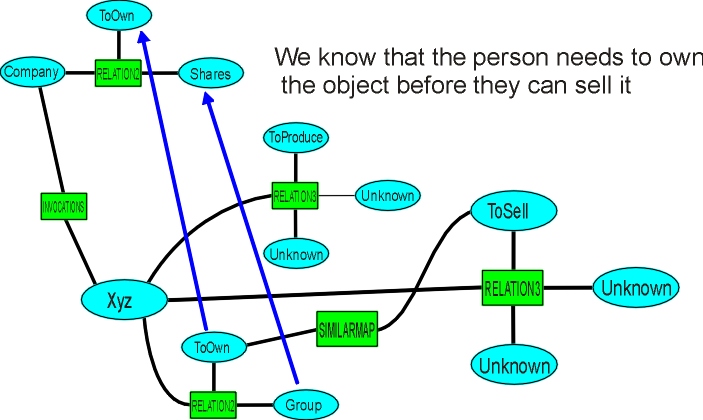Using Context to Determine Compatibility
“…that Xyz sold recently”
We have a relative pronoun clause, and now need to determine where to
anchor it, when it is preceded by, or is embedded in, a prepositional chain.
There are several possible objects – which one is most likely?
We have a relation, with Xyz as its subject. This should help us
narrow down the likely suspects. How can we use the fact that Xyz has to own it (or
produce it or trade in it or have it in stock) to sell it?
Without context, we would need to define a sellable thing very
broadly, but that doesn’t help in providing a basis for decision in a specific case.

We need to inherit a structure that will allow us to go directly to
the things that Xyz owns, and then go up the chain looking for things that a company owns,
and so on.
We can use the SYNONYMMAP
mechanism, renamed to make it clear it is not a synonym. See SIMILARMAP
We do the same thing for "Xyz sold it recently" - the
"it" is evaluated against the things that Xyz can sell (or people have bought
from Xyz, or Xyz owns or makes or trades in).
Lawyer Work
“we worked
on that”
We know that “we” is a firm of lawyers – that should
improve our discrimination on the sorts of things they would work on – torts,
contracts, mergers and acquisitions, legal services.
How do we use our knowledge about one parameter to improve our
discrimination on another?
We want to open up
different channels based on what we know.
If we have a relation with one or more known parameters, and one or
more unknown ones, we get the parents of the known parameter(s), check for values of
unknown parameter, using a direct relation and working across synonyms and antonyms of the
relation and using mapping to determine where we should look for a match.
If we are looking for the “that” in “we worked on
that”
We get the parents of LegalEagle plus LegalEagle for a ToWork relation. If we
find one, we add the objects and their parents to the objects we get from the relation
template.
We might find
LegalEagle
works on transactions, approvals, official reports
Law firm works on lawyer work, which leads
to contracts, M&A.
If the subject was a banker, we would find a different set, with some
overlap – transactions, loan agreements, hedging, finance.
Using this method, if we have a buyer, we can look for sales made to
the buyer to see what sorts of things they buy.
If “we removed references” and “we” happen to be
a lawyer, then we expect they were removed from a legal document.
Just using the parents of an object is far too general to be of much
use in deciding who did what when we have anaphora and a jumble of objects to choose from.
Relations allow us to go horizontally through the structure, at many different levels, and
to use specific information that we have learnt to learn more.